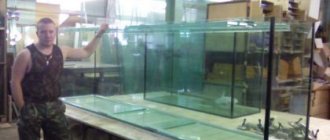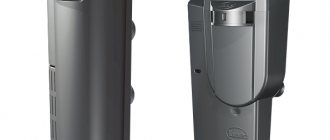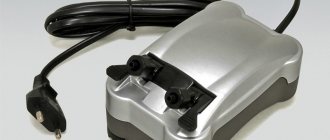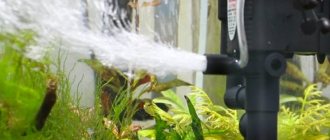To independently manufacture or repair aquariums, it is necessary to select the products that best meet the requirements stated for the operation of the fish tank. The best option is silicone transparent sealant for aquariums. It is able to fasten glass walls, securely fixing them for a long time. We will look at how to make a choice and what to focus on in this article.
Aquarium
What should aquarium glue be?
The sealant should solve a number of problems. This may be the need to eliminate leaks, or create relief on the bottom surface. It must be suitable for fixing walls and decorative elements. Not every store-bought sample is suitable for these tasks. Let's consider the requirements that must apply to the sealing composition:
- Harmlessness. The requirement is basic. The release of harmful substances into the water will lead to the death of fish and plants. Analyzing the compositions of various types of sealants, we can come to the conclusion that bitumen and synthetic mixtures are not suitable for repairs.
- Elasticity. This characteristic allows it to withstand high pressure exerted on glass walls. The use of mixtures with poor elasticity will lead to cracking of the glass.
- No antiseptics. Some types of sealants are supplemented with antibacterial components that prevent the appearance of mold and fungal deposits. Such substances have a bad effect on the health of living organisms.
- No dyes. They also have a bad effect on the general condition of aquatic inhabitants.
- Reliability. Must withstand high loads throughout its service life.
Subtleties of use
Silicone glue cannot be painted with any paints. Therefore, when applying, you need to ensure that the sealant does not come into contact with decorative elements and the metal frame. Also, it cannot be applied in several layers. To fix the leak, you will have to completely remove the old sealant. If you apply a second layer, it will simply fall off.
Reference! The glass must be cleaned before gluing, otherwise the elements will not be able to be joined. Some aquarists prefer to get a new tank, since gluing an old one together takes a lot of time and effort. If the aquarium is new, there are no special problems.
Types of sealants
Each type of product is, to one degree or another, suitable for fastening glass and fixing it, but for living organisms to live in, it is necessary to select certain compositions. Let's consider several types, their negative or positive aspects:
- Acrylic. Low level of moisture resistance, therefore not recommended for use in aquariums.
- Polyurethane, bitumen and polysulfide. Of all the options listed, not one is suitable for improving fish housing due to their toxicity.
- Epoxy. Allowed, but not recommended for use. The reason is the careful preparation of the surface and the long drying process.
- Cold welding. It dries quickly and is non-toxic, so it can be used for repairs and assembling aquariums.
- Silicone. The best option that meets all the necessary requirements: it is elastic, not afraid of water, has good adhesion properties and does not emit harmful substances.
When purchasing silicone sealant, you can see the mark “for aquariums and glass” on the product packaging. When choosing a product, pay attention to the color of the mixture.
Silicone glue
Reasons influencing the choice of universal silicone sealant:
- Safety of use.
- Easy to use.
- Due to its high elasticity, it maintains the strength of the glass structure.
- The hardening process occurs within 20 minutes.
- Has a long service life.
- Easy to use.
- Capable of withstanding impressive loads - up to 200 kilograms.
Black silicone
Unlike other types, black silicone has greater strength and hardening speed - this is what most aquarium owners think. I would like to disabuse you of this, since color cannot influence the strength qualities of the mixture; it only plays the role of a decorative component. Black compounds look good in large-volume aquariums.
Black sealant
Transparent silicone
The transparency of the material gives the structure a weightless state, masking the seam joints. This sample looks great in vessels of any size. The disadvantage is the color change. Algae deposits and the influence of a humid environment change the color of the product over time, requiring timely replacement of the sealing composition.
Transparent
General requirements
To glue a glass aquarium together, not just any construction sealant will do. Aquarium glue must meet the following criteria:
- Safety. The product should not contain toxic components, otherwise the living inhabitants of the aquarium will be at risk. If the glue contains toxic substances, the vessel made with it cannot be used for fish.
- Elasticity. After polymerization and drying, a good sealant does not lose its extensibility. This property helps the product to withstand water pressure, not crack and not lose adhesion to the glass.
- Long service life. Over the years of operation, the tank experiences increased load associated with the difference in temperature and pressure from inside and outside. The composition of a specialized product should not lose its properties over time.
Attention! An important quality indicator is moisture resistance. If the glue dissolves and reacts with water, it is not suitable for aquariums.
Benefits of silicone
Silicone sealant is in great demand among aquarium owners due to several advantages:
- Environmentally friendly. Unlike other products, the silicone analogue is distinguished by its lack of toxicity. It does not contain harmful components.
- The material is durable and reliable. These characteristics were identified based on experiments conducted and reviews from aquarium owners. According to experimental data, glass walls fixed with silicone sealant can withstand loads of up to 200 kilograms.
- Moisture resistance. This indicator is important when choosing a mixture for sealing joints, since the fish’s habitat consists of water.
For the initial setting of silicone glue, 20 minutes is enough. It takes a day to completely harden. These figures are only averages. To find out the exact time, examine the product packaging.
Purpose
In operating aquariums, from time to time cracks, chips, and depressurization of seams appear.
Causes of damage:
- improper operation;
- mechanical impact;
- tough transportation;
- long-term storage under the sun.
Glass is a durable material that can withstand quite a large load, but leaks sometimes occur at the junction of the plates. We have to repair the aquarium: seal joints, glue cracks, or even rebuild the entire structure. This is what aquarium sealant is used for - not household glue, but a special non-toxic product.
Minor repairs are not the only purpose of sealant. You can’t do without it when building an aquarium from scratch. Experienced aquarists prefer to independently create “banks” of fancy silhouettes for specific conditions. In addition, glue is necessary for installing decorations on the walls and bottom of the aquarium.
Varieties of silicone
There are three main types of silicones:
- Antiseptic. Used in high humidity conditions. Prevents fungal growths and mold from appearing. The drug belongs to the toxic category, therefore it is not recommended for repairing or assembling aquariums.
- Acidic. They have a characteristic vinegar smell, while releasing acid-containing components.
- Neutral. Compatible with any type of surface. It is the best option for use when sealing seams in glass structures.
Among the positive qualities of neutral silicone are the following:
- durable;
- moisture resistant;
- elastic;
- operating temperature – from -70 to +70 0.
Silicone has some features:
- Surface painting of the layer is not possible.
- Applying a secondary layer will cause it to peel off.
- Before you begin repairing the tank, you must clean the surface of the old coating.
Product examples
Silicone for aquariums is what people call products for gluing fish containers together. The most commonly used compositions:
- Tytan is a special high-quality aquarium glue produced in Poland. It provides a long-lasting seal, but is quite expensive. This is an ideal option for gluing large aquariums.
- Soudal is a glue from Belgium, specifically for assembling and repairing aquariums. Suitable for containers of any size. It is considered the best option in terms of quality.
- Krass is another Polish sealant that is more affordable. It has acceptable quality and is mainly used for gluing small containers up to 50 liters.
- Okyanys Kimya is a Turkish product that provides reliable and durable glass bonding.
- “Moment sealant” is a special silicone sealant for aquariums from the famous “Moment” series from Henkel.
How to choose an aquarium sealant?
Choose a sealant responsibly, as a poor-quality mixture will lead to undesirable consequences.
Let's figure out how to choose:
- When choosing the best composition, give preference to neutral silicone sealant. Please note that the products are much more expensive than their acidic, antiseptic counterparts.
- Before purchasing a product, check its expiration date. Do not buy formulations that have expired or are approaching their expiration date. Old products lose their quality and cannot create a reliable seal.
- Colorlessness. The absence of color makes the glass container more harmonious and aesthetically pleasing.
- Availability of marking “for aquariums and glass” and manufacturer’s brand.
Compound
Universal waterproof aquarium adhesive. It can be used in different ways in everyday life for gluing surfaces. Its composition is complex. The silicone product contains rubber, vulcanizer, strength enhancer, plasticizer, and adhesive.
Important! Silicone sealants may contain dyes. If the individual composition is not intended for aquariums, it may be harmful to fish. It is also important to pay attention to the fact that the product is neutral.
Brief overview of sealants
Construction markets and stores, as well as online sites, offer sealing mixtures from various companies. I would like to highlight among those in demand.
MOMENT
is engaged in the production of special compositions for aquariums that contain 100% silicone polymer. The advantage of this specimen is the absence of solvents.
Moment
Has high strength. The sample is capable of withstanding tensile strength up to 2.3 MPa. Resistant to direct sunlight, temperature changes, vibration fluctuations. Suitable for use in containers filled with salt water where marine fish live.
KRASS
An inexpensive option for a sealant, the volume of which does not exceed 300 milliliters. The manufacturer of these products is located in Poland. The sample has a sufficient degree of elasticity. The downside of the product is the release of vinegar vapors when the components of the mixture are activated.
The manufacturer indicates that the product is absolutely safe, but it is better to limit yourself to using a neutral sealant.
Advice! You should not use Moment when sealing containers exceeding a volume of 100 liters. This can cause the formation of ruptures and defects.
DOW CORNING 7093
Refers to neutral, one-component compositions. Non-toxic, does not emit an unpleasant odor when dried. It resists mechanical, chemical and ultraviolet influences well. Has a long service life. For the sample to begin to harden, it is enough to wait 20-30 minutes.
Capable of maintaining its qualities in a temperature range from -50 to +180 0. The tensile tests carried out gave results of 1.7 MPa. The cost of the product cannot be called low.
TYTAN
This sample is capable of creating a strong, durable seam that is leak-proof and durable. Working with sealant from this manufacturer is simple and does not cause any difficulties. The mixture contains no solvents and is therefore non-toxic.
TYTAN
Tests carried out in laboratory conditions showed that Titan sealant has a tensile strength of 0.55 MPa. It does not harden very quickly - 3 millimeters per day. Retains its qualities at temperatures from -50 to +180 0.
SOUDAL
Sealing agents presented by the Belgian manufacturer are offered in a large assortment on the markets. One of these is a sample for treating aquariums. Refers to single-component products that do not emit hazardous substances.
SOUDAL
The elasticity of the product allows it to withstand heavy loads. Ease of use and moisture resistance put the product in the category of demand. The drying process is quick, and the coating retains its original appearance for a long time. Another advantage is the absence of toxic substances. SOUDAL sealant is in demand among aquarists.
Popular brands
Aquarium glue is produced by most sealant companies. Among all the variety, you can choose a high-quality and inexpensive composition.
Aquarists often choose the following sealants:
- Titan - sealants of the highest quality are produced under the brand name. The downside is the high price. Pros - sealing for many years, the ability to reliably glue large aquariums.
- Soudal is one of the best sealants for safe and high-quality work with aquariums. It is used without risks for the largest tanks.
- Krass is a cheaper sealant, but this does not affect the quality. It can be used for internal gluing of small aquariums.
- Okyanus Kimya is not yet a very well-known brand from a Turkish manufacturer. However, the company produces high-quality sealants with an extended service life.
Reference! Domestic sealants are cheaper, meet all requirements, but do not have such a long service life in comparison with foreign samples. In addition, imported sealants dry faster - 24 hours.
Instructions on how to glue a glass aquarium
Let's figure out how to properly use silicone when gluing a fish tank:
- In the places of planned joining, the glass is glued with paper tape. This approach will allow you to create a correct, even seam, freeing the coating from contamination.
- Degrease the surface. Products containing alcohol or acetone are suitable for this. After processing the seams, re-inspect for lint.
- To achieve the greatest accuracy, it is recommended to set beacons. Apply glue in several places, then let dry. In the future, they will serve as a guide for aligning the elements.
- Apply silicone, gently squeezing it onto the seam. You can smooth out the glue using a rubber spatula. Then we move on to the next segment.
Assembly
The appearance of bubbles - control measures
Sometimes inaccurate gluing of surfaces leads to the entry of air and the formation of bubbles.
By adding a little sealant to the seam and tightening the parts tightly, they can be eliminated. The air gap can be removed with a rubber spatula. If a problem is detected when the silicone has already set to the surface, it is enough to pierce the bubbles with a needle.
If the seam turns out to be mostly of poor quality, then it is better to re-glue it.
What is important to know and be sure to take into account
There are two methods for gluing an aquarium with your own hands. These include:
- Installing glass plates on the bottom. The method is suitable for assembling small structures.
- Fastening glass around the bottom. A popular method that allows the manufacture of structures of any size due to its high strength.
To make reliable seams, you need to work with adhesives correctly. To do this, you need to take into account a number of features:
- Clean future gluing areas from dirt and dust in advance. Wipe with a cloth moistened with medical alcohol, acetone or gasoline to degrease the surfaces.
- Excess glue is removed using a rag soaked in vinegar.
- While the structure is being repaired, the fish need to be transplanted into separate jars.
- Sealing up an aquarium is sometimes more difficult than buying a new glass panel. If the damage is serious, you need to purchase a new part.
- Do not use adhesives that have expired.
Before sealing the aquarium, it is advisable to draw a sketch of the finished structure. It is important to choose the right shape so that it can be conveniently placed among other interior items.









